Family: Orussidae
Family common name: parasitic woodwasps
Subfamily: Ophrynopinae
Genus: Ophrynopus Konow, 1897
Subgenera: none
The Orussidae are small, predominantly black sawflies with cylindrical bodies and globular heads (Eaton and Kaufman 2007Eaton and Kaufman 2007:
Eaton ER and Kaufman K. 2007. Kaufman Field Guide to Insects of North America (Kaufman Field Guides). Houghton Mifflin Harcourt. 391 pp.). They are distinctive because they are the only sawfly family that is parasitic instead of phytophagousphytophagous:
feeding on plants
(Furniss and Carolin 1977Furniss and Carolin 1977:
Furniss RL and Carolin VM. 1977. Western forest insects. United States Deptartment of Agriculture Forest Service Miscellaneous Publication 1339: 1-655.). Current Hymenoptera phylogenies suggest that the Orussidae are the most closely related extantextant:
in existence; opposite of extinct
sawfly family to the suborder Apocrita, and specifically parasitic wasps (Vilhelmsen 2004Vilhelmsen 2004:
Vilhelmsen L. 2004. The old wasp and the tree: fossils, phylogeny, and biogeography in the Orussidae (Insecta, Hymenoptera). Biological Journal of the Linnaen Society 82: 139-160.).
Ophrynopus are 8–14 mm in length (Furniss and Carolin 1977Furniss and Carolin 1977:
Furniss RL and Carolin VM. 1977. Western forest insects. United States Deptartment of Agriculture Forest Service Miscellaneous Publication 1339: 1-655.). They share several remarkable morphological characters with other Orussidae, including antennal insertions located extremely low on the face, reduced wing venationvenation:
the network of veins on a wing
, and a relatively long and thin ovipositorovipositor:
the female organ that deposits eggs and is used to drill into plant tissue, located at the apex of the abdomen, made up of the lance and lancet
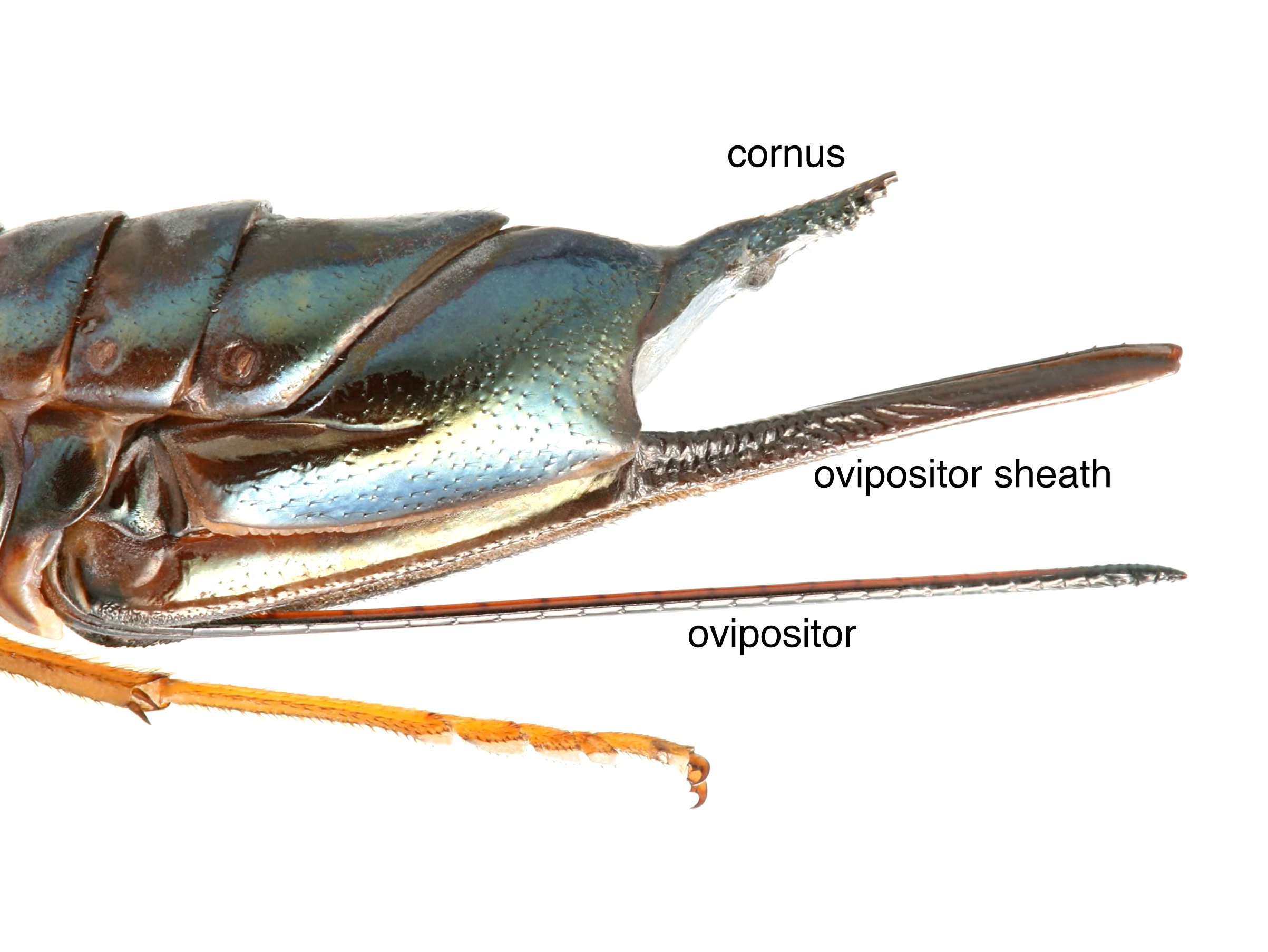 (Vilhelmsen et al. 2014Vilhelmsen et al. 2014:
(Vilhelmsen et al. 2014Vilhelmsen et al. 2014:
Vilhelmsen L, Blank SM, Liu Z, and Smith DR. 2014. Discovery of a new species confirms Oriental origin of Orussus Latrielle (Hymenoptera: Orussidae). Insect Systematics and Evolution 45: 51-91. https://doi.org/10.1163/1876312X-00002087). This genus is relatively rare in collections and poorly known (Blank et al. 2010bBlank et al. 2010b:
Blank SM, Vilhelmsen L, and Smith DR. 2010b. Ophrynon (Hymenoptera: Orussidae) in California: diversity, distribution, and phylogeny. Insect Systematics amp; Evolution 41: 3-27. https://doi.org/10.1163/139956009X12550095535756).
There are 15 extantextant:
in existence; opposite of extinct
described species worldwide (Vilhelmsen et al. 2013Vilhelmsen et al. 2013:
Vilhelmsen L, Blank SM, Costa VA, Alvarenga TM, and Smith DR. 2013. Phylogeny of the ophrynopine clade revisited: review of the parasitoid sawfly genera Ophrella Middlekauff, Ophrynopus konow and Stirocorsia konow (Hymenoptera: Orussidae). Invertebrates Systematics 27: 450-483. https://doi.org/10.1071/IS13006). The highest diversity is in South America (Smith and Middlekauff 1987Smith and Middlekauff 1987:
Smith DR and Middlekauff WW. 1987. Suborder Symphyta. In: Stehr FW ed. Immature Insects. Kendall/Hunt Publishing Company. Vol. 1: 754 pp.). Only two species occur in North America (Taeger et al. 2010Taeger et al. 2010:
Taeger A, Blank SM, and Liston AD. 2010. World Catalog of Symphyta (Hymenoptera). Zootaxa 2580: 1-1064.).
A key to North and Central American species of Ophrynopus is included in Middlekauff 1983Middlekauff 1983:
Middlekauff WW. 1983. A revision of the sawfly family Orussidae for North and Central America (Hymenoptera: Symphyta, Orussidae). University of California Publications in Entomology 101: 1-46..
 (Middlekauff 1983Middlekauff 1983:
(Middlekauff 1983Middlekauff 1983: longer than body length and thread-like; when withdrawn, ovipositorovipositor:
longer than body length and thread-like; when withdrawn, ovipositorovipositor: hidden inside the body, sometimes coiled (Middlekauff 1983Middlekauff 1983:
hidden inside the body, sometimes coiled (Middlekauff 1983Middlekauff 1983: ; distaldistal:
; distaldistal: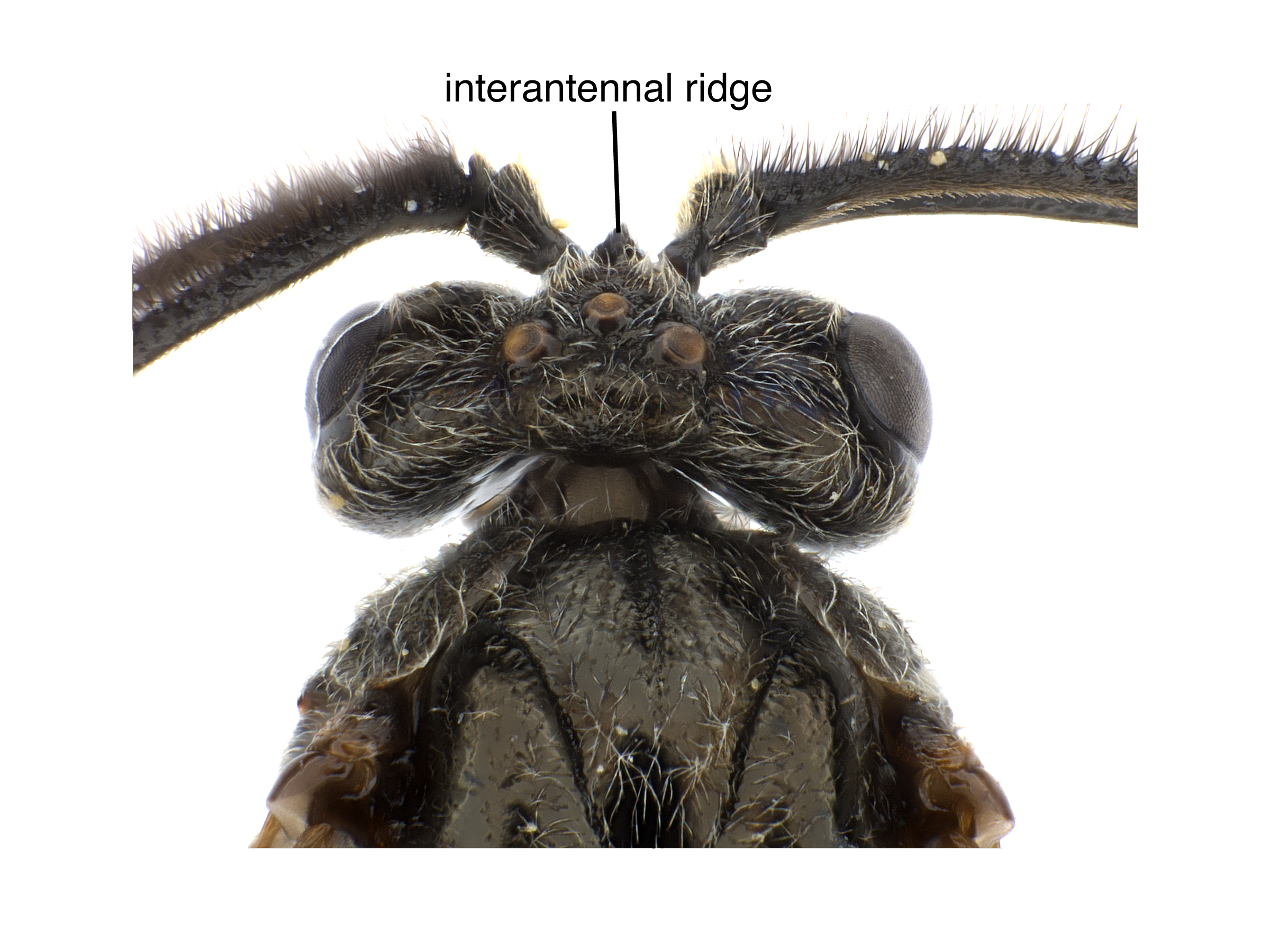 present extending along entire outer side of compound eye down to antennal socket (Middlekauff 1983Middlekauff 1983:
present extending along entire outer side of compound eye down to antennal socket (Middlekauff 1983Middlekauff 1983: on face between the compound eyes and below coronal crest present (Middlekauff 1983Middlekauff 1983:
on face between the compound eyes and below coronal crest present (Middlekauff 1983Middlekauff 1983: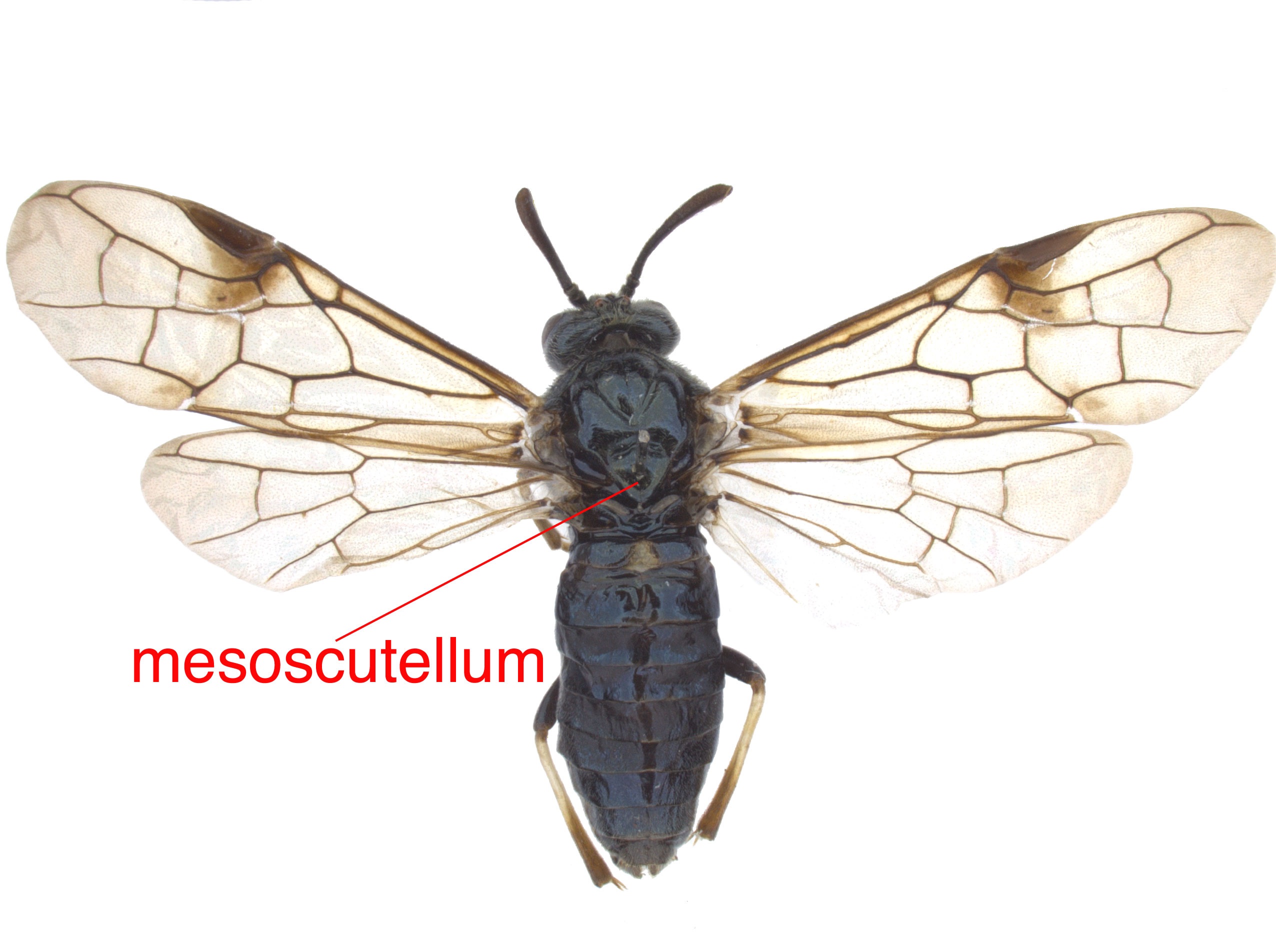 parallel with the anterioranterior:
parallel with the anterioranterior: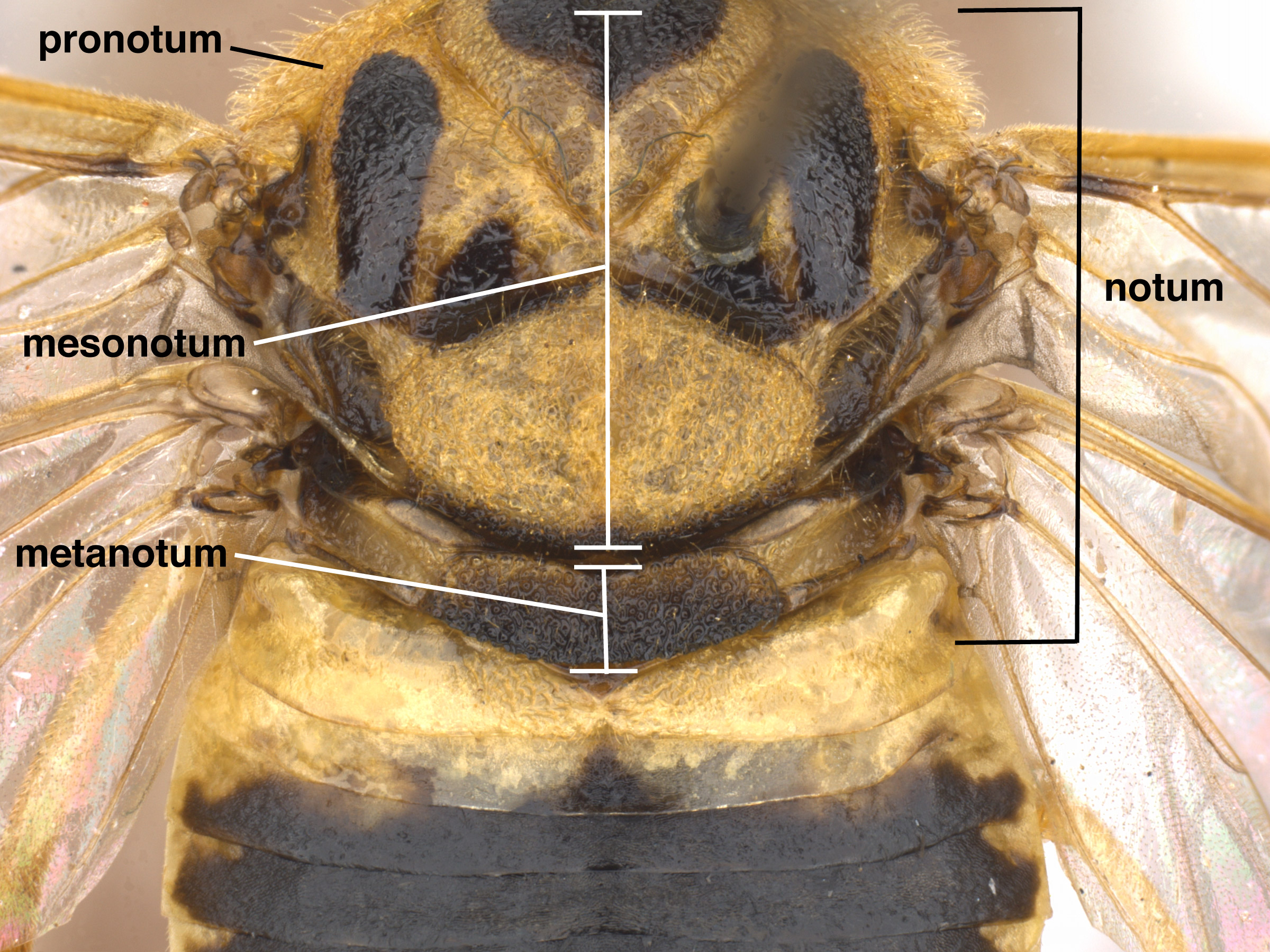 (Vilhelmsen et al. 2013Vilhelmsen et al. 2013:
(Vilhelmsen et al. 2013Vilhelmsen et al. 2013: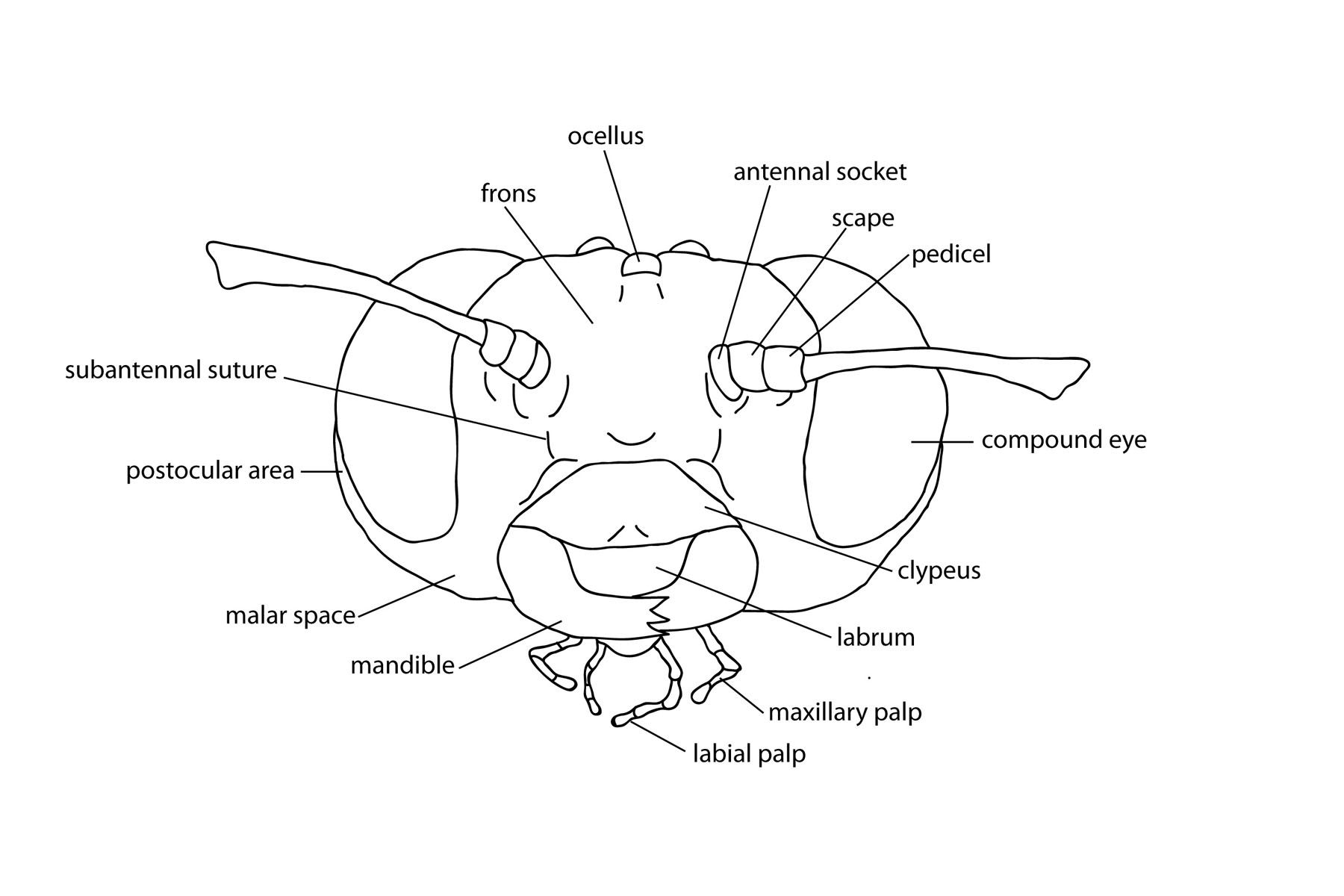 five-segmented and elongate (Middlekauff 1983Middlekauff 1983:
five-segmented and elongate (Middlekauff 1983Middlekauff 1983: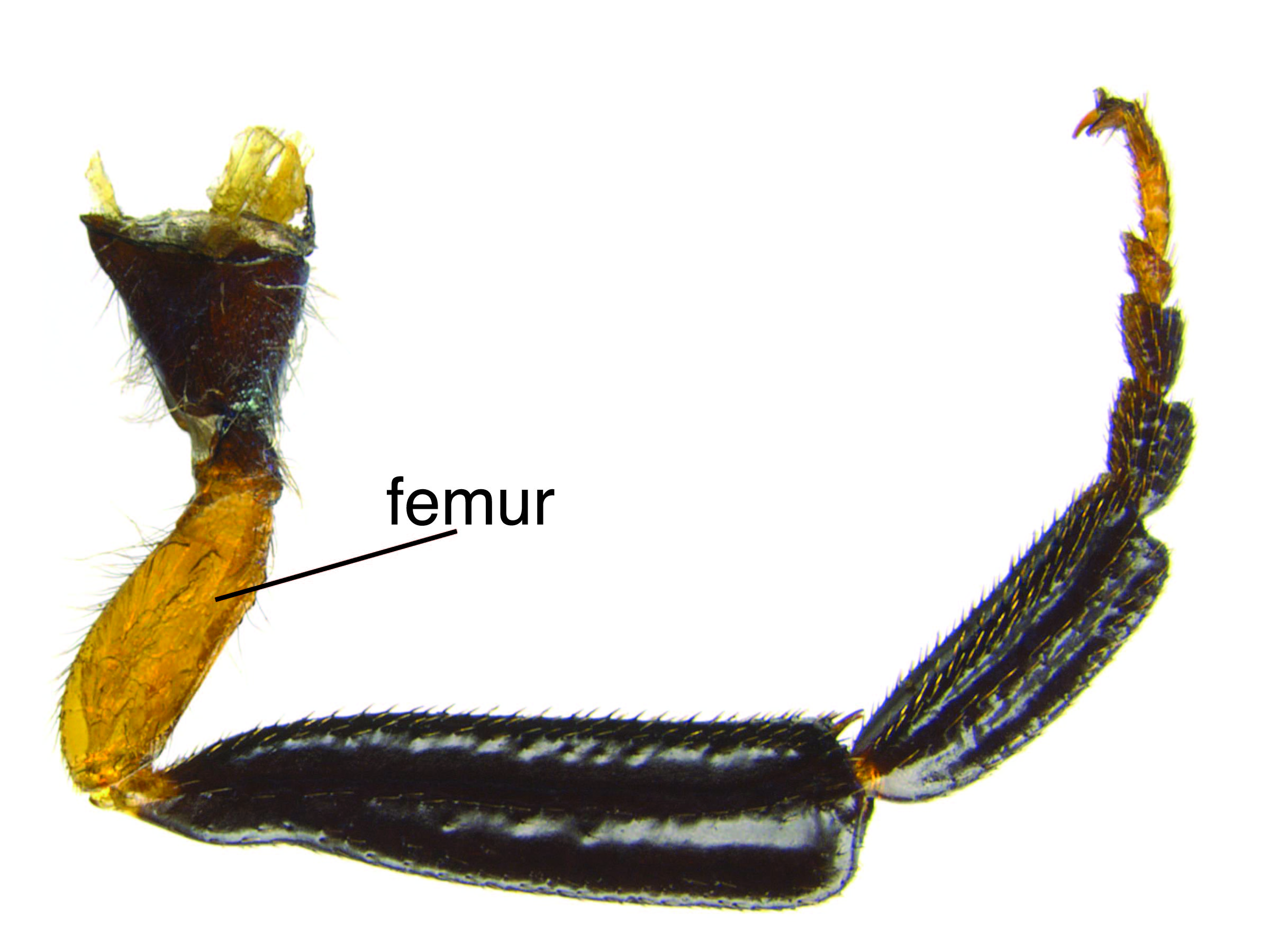 with a triangular projection laterodistally (Vilhelmsen et al. 2013Vilhelmsen et al. 2013:
with a triangular projection laterodistally (Vilhelmsen et al. 2013Vilhelmsen et al. 2013:Orussidae are morphologically distinct among sawfly families because of the body shape and location of antennaeantenna:
the sensory organ emerging from the front of the head, usually between the compound eyes and above the clypeus; includes the flagellum, scape and pedicel
 on head. Ophrynopus is easily confused with other genera of the family. It can be distinguished by the presence of longitudinal carinaecarina:
on head. Ophrynopus is easily confused with other genera of the family. It can be distinguished by the presence of longitudinal carinaecarina:
a ridge or raised edge
 between the eyes and the shape of the mesoscutellummesoscutellum:
between the eyes and the shape of the mesoscutellummesoscutellum:
the anterior section of the scutellum
 and the maxillary palpimaxillary palpus:
and the maxillary palpimaxillary palpus:
appendage emerging laterally from the maxilla; often segmented
 (Middlekauff 1983Middlekauff 1983:
(Middlekauff 1983Middlekauff 1983:
Middlekauff WW. 1983. A revision of the sawfly family Orussidae for North and Central America (Hymenoptera: Symphyta, Orussidae). University of California Publications in Entomology 101: 1-46.).
none
The Orussidae are external parasitoids of other insects. The documented hosts in South America for species of Ophrynopus include Cerambycidae beetle Oncideres germarii living in Prosopis chilensis (Chilean mesquite tree) and a Xiphydriidae sawfly Derecyrta sp. in Araucaria angustifolia (Brazilian pine) (Vilhelmsen and Smith 2002Vilhelmsen and Smith 2002:
Vilhelmsen L and Smith DR. 2002. Revision of the lsquo;ophrynopinersquo; genera Argentophrynopus gen. n., Guiglia Benson, Kulcania Benson, Ophrella Middlekauff, Ophrynon Middlekauff, Ophrynopus Konow, and Stirocorsia Konow (Hymenoptera: Orussidae). Insect Systematics amp; Evolution 33 (4): 387-420., Vilhelmsen et al. 2013Vilhelmsen et al. 2013:
Vilhelmsen L, Blank SM, Costa VA, Alvarenga TM, and Smith DR. 2013. Phylogeny of the ophrynopine clade revisited: review of the parasitoid sawfly genera Ophrella Middlekauff, Ophrynopus konow and Stirocorsia konow (Hymenoptera: Orussidae). Invertebrates Systematics 27: 450-483. https://doi.org/10.1071/IS13006). There is a Mexican record of O. nigricans emerging from a stem of Agave nelsoni containing a Prodoxus pallida moth (Smith 2006dSmith 2006d:
Smith DR. 2006d. Superfamilia Orussoidea y familia Orussidae. In: Fernandez F and Sharkey M, eds. Introduccion los hymenoptera de la region neotropical. Universidad Nacional de Colombia.). This association may be spurious since no other Orussidae are parasitoids of Lepidoptera (Vilhelmsen et al. 2013Vilhelmsen et al. 2013:
Vilhelmsen L, Blank SM, Costa VA, Alvarenga TM, and Smith DR. 2013. Phylogeny of the ophrynopine clade revisited: review of the parasitoid sawfly genera Ophrella Middlekauff, Ophrynopus konow and Stirocorsia konow (Hymenoptera: Orussidae). Invertebrates Systematics 27: 450-483. https://doi.org/10.1071/IS13006).
To find a suitable oviposition site, Ophrynopus females run up and down fallen or standing dead or damaged tree trunks, using their antennaeantenna:
the sensory organ emerging from the front of the head, usually between the compound eyes and above the clypeus; includes the flagellum, scape and pedicel
 to tap repetitively on the log. The behavior of running up and down, with the wings folded and effectively hidden, mimics the behavior of a carpenter ant. Whether they are able to sense a host presence in the log by chemical signals or by vibrations caused by the tapping of antennaeantenna:
to tap repetitively on the log. The behavior of running up and down, with the wings folded and effectively hidden, mimics the behavior of a carpenter ant. Whether they are able to sense a host presence in the log by chemical signals or by vibrations caused by the tapping of antennaeantenna:
the sensory organ emerging from the front of the head, usually between the compound eyes and above the clypeus; includes the flagellum, scape and pedicel
 is unclear (Powell and Turner 1975Powell and Turner 1975:
is unclear (Powell and Turner 1975Powell and Turner 1975:
Powell JA and Turner WJ. 1975. Observations on oviposition behavior and host selection in Orussus occidentalis (Hymenoptera: Siricoidea). Journal of the Kansas Entomological Society 48 (3): 299-307., Gourlay 1926Gourlay 1926:
Gourlay ES. 1926. Echthromorpha intricatoria , found in New Zealand. Entomologists Monthly Magazine 62: 169-171.).
The biology of Ophrynopus larvae is unknown (Gourlay 1926Gourlay 1926:
Gourlay ES. 1926. Echthromorpha intricatoria , found in New Zealand. Entomologists Monthly Magazine 62: 169-171.). For a description of the life history of a closely related sawfly in the Orussidae, see Orussus.
World: The genus is widespread in tropical regions of Asia and the Americas. Species in East and Southeast Asia occur in Japan, Korea, south to Laos and Vietnam, and east to Indonesia and the Philippines (Vilhelmsen et al. 2013Vilhelmsen et al. 2013:
Vilhelmsen L, Blank SM, Costa VA, Alvarenga TM, and Smith DR. 2013. Phylogeny of the ophrynopine clade revisited: review of the parasitoid sawfly genera Ophrella Middlekauff, Ophrynopus konow and Stirocorsia konow (Hymenoptera: Orussidae). Invertebrates Systematics 27: 450-483. https://doi.org/10.1071/IS13006). In the Americas, Ophrynopus ranges from the very southern United States south to northern Argentina (Smith 2006dSmith 2006d:
Smith DR. 2006d. Superfamilia Orussoidea y familia Orussidae. In: Fernandez F and Sharkey M, eds. Introduccion los hymenoptera de la region neotropical. Universidad Nacional de Colombia.).
North America: There are two species in North America. Ophrynopus nigricans occurs in Mexico and the state of Texas (Vilhelmsen et al. 2013Vilhelmsen et al. 2013:
Vilhelmsen L, Blank SM, Costa VA, Alvarenga TM, and Smith DR. 2013. Phylogeny of the ophrynopine clade revisited: review of the parasitoid sawfly genera Ophrella Middlekauff, Ophrynopus konow and Stirocorsia konow (Hymenoptera: Orussidae). Invertebrates Systematics 27: 450-483. https://doi.org/10.1071/IS13006). Ophrynopus hansoni occurs in Costacosta:
the robust vein on the anterior margin of the wing; vein C
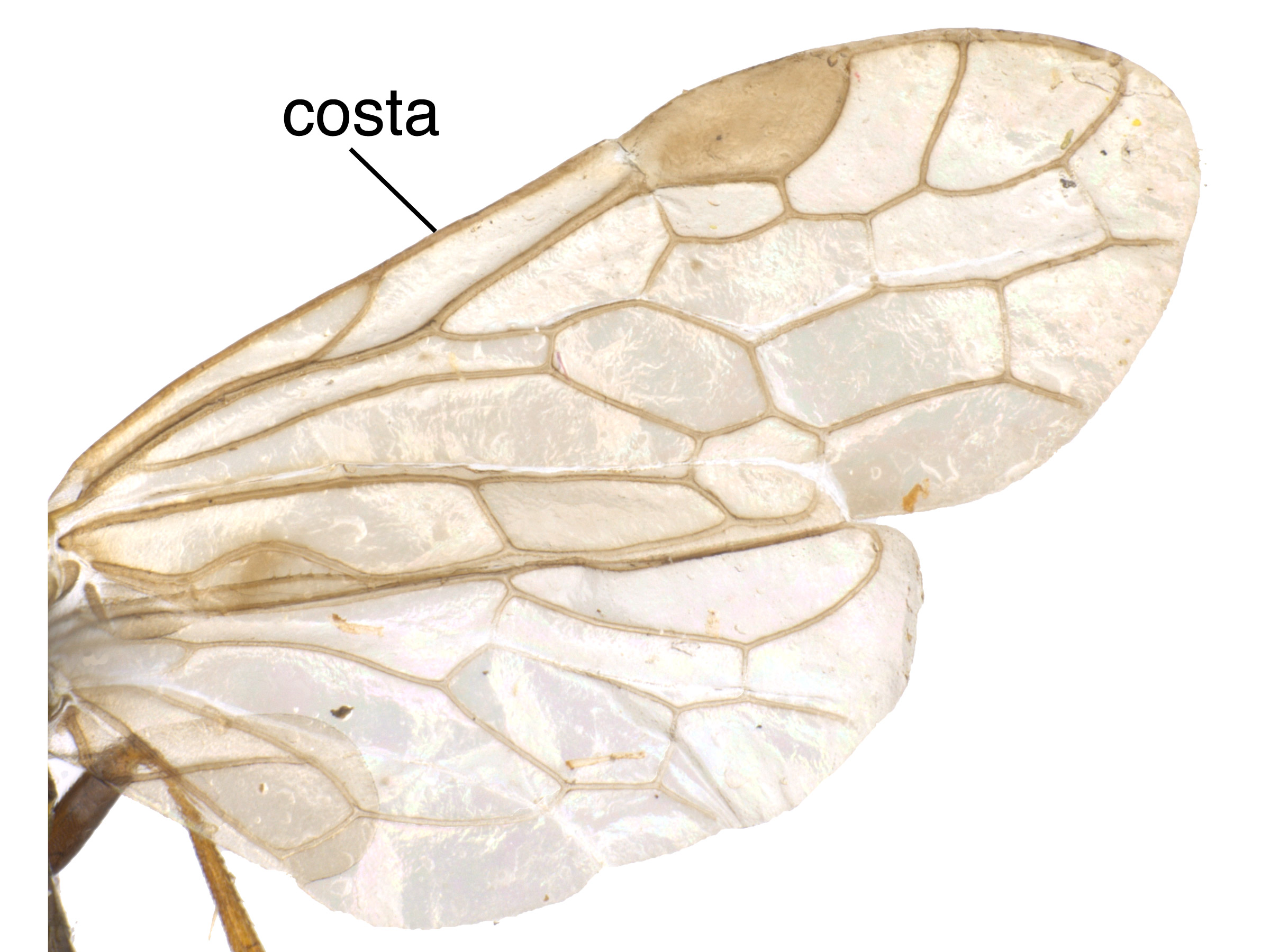 Rica and Trinidad (Vilhelmsen 2004Vilhelmsen 2004:
Rica and Trinidad (Vilhelmsen 2004Vilhelmsen 2004:
Vilhelmsen L. 2004. The old wasp and the tree: fossils, phylogeny, and biogeography in the Orussidae (Insecta, Hymenoptera). Biological Journal of the Linnaen Society 82: 139-160.).
Map data from: GBIF.org (26 June 2019) GBIF Occurrence Download Ophrynopus
Details about data used for maps can be found here.